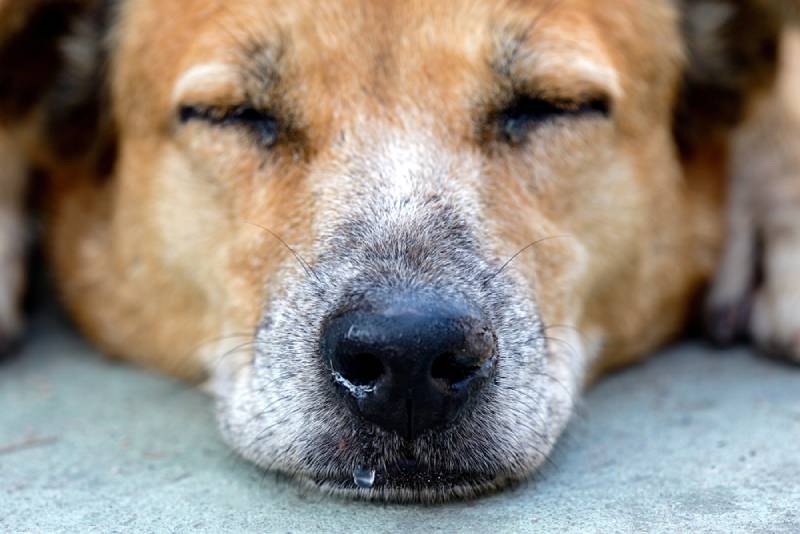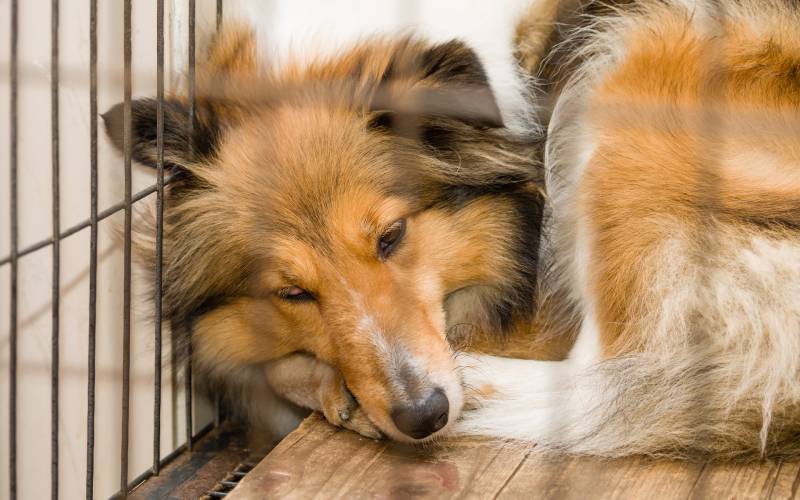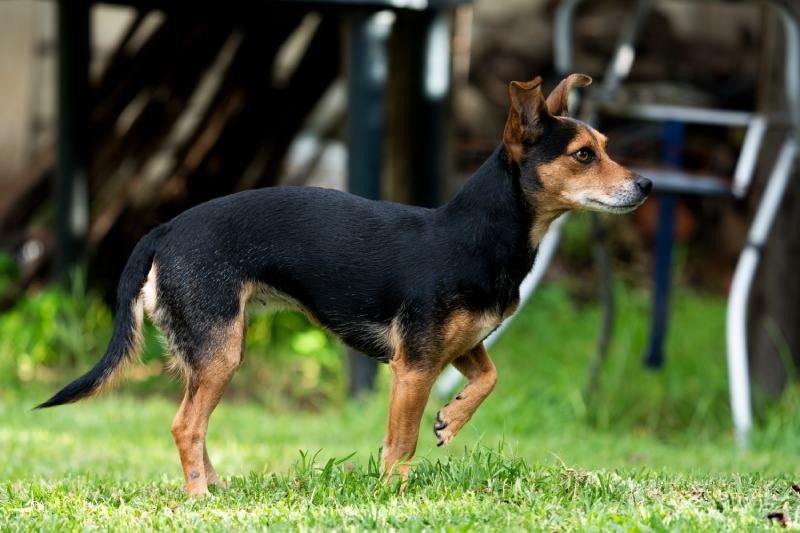Dog Nose Bleeds: Types, Causes & What to Do (Vet Answer)

Updated on

Click to Skip Ahead
The role of a dog’s nose is to keep warm and moisten the air that the dog breathes. The inside of the nose is covered with mucosa that is well vascularized, being provided with a rich network of blood vessels. When this mucosa is damaged, the blood vessels tend to bleed. Once a blood vessel begins to bleed, the bleeding tends to recur because the clot or scar is easy to dislodge.
Types of Nosebleeds in Dogs
Nosebleeds, also called epistaxis, can come from the nostrils, nasal cavity, or upper part of the throat behind the nose (nasopharynx). When the bleeding comes from the nostrils and nasal cavity, it is called anterior bleeding, and when it comes from behind the nose, it is called posterior bleeding. The latter is sometimes more severe and can be a cause for concern.

The 14 Common Causes of Nosebleeds in Dogs
The causes of nosebleeds in dogs can be represented by the following.
1. Simple Trauma
Dogs can easily injure their noses, which can lead to acute or sudden nosebleeds. It happens especially in breeds with long noses and can occur when they accidentally hit a surrounding object (especially an object with sharp corners) or fight with other animals.
- Nosebleed
- Scratches on the face
- Pawing at their face
- Watery eyes
- Yelping
- Wounds
2. Nasal Foreign Body
Your dog may end up with a foreign body in their nose, especially when you take them for a walk (examples include awns/grass seeds, blades of grass, small stones or gravel, pieces of wood, fabric, etc.). They can totally or partially block your dog’s nose.
According to studies, it seems that dogs up to 7 years of age and larger than 22 pounds (10 kilograms) are more prone to this problem. Also, grass awns are the most common foreign bodies extracted from dogs’ noses.
- Nosebleeds
- Sneezing
- Discharge from the nose, usually one sided
- Noisy breathing
- Retching
- Bad breath
- Drooling (sometimes)
- Coughing (sometimes)
3. Dental Disease
Dental disease, particularly tooth root abscess and infection, may also cause nosebleeds when affected tooth or teeth are on the upper jaw.
- Bad breath
- Drooling
- Reduced appetite or pickiness with food
- Inflamed, red, or swollen gums (gingivitis)
- Difficulty chewing or awkward chewing to one side
- Blood in saliva
- Oral pain
4. Upper Respiratory Tract Inflammation and Infection
Respiratory infections in dogs can be caused by viruses, bacteria, or fungi. However, sometimes inflammation of the nose and nasal passages, also called rhinitis, can be of an unknown cause or idiopathic and may lead to nosebleeds.
- Nasal discharge, sometimes with blood
- Eye discharge
- Fever
- Sneezing
- Coughing
- Gagging
- Wheezing
- Labored breathing
- Lack of appetite
- Lethargy
- Vomiting and retching
Upper respiratory infections can be transmitted easily to other dogs (through contaminated accessories or secretions and saliva). One of the most contagious infections is kennel cough.

5. Nasal Tumors
Nasal tumors are abnormal tissue growths that occur inside the nose (nasal cavity). They can be malignant or benign. Nasal tumors are of several types, the most common being nasal adenocarcinoma.
- Facial deformity
- Epistaxis
- Nasal discharge (pus-like or with blood)
- Persistent tearing (epiphora)
- Difficulty breathing or noisy breathing (when the tumor blocks the airways)
- Sneezing
- Coughing
- Lethargy
- Decreased appetite
- Weight loss
6. Ehrlichiosis
Ehrlichiosis is a tick-borne disease, being transmitted by the lone star tick (Amblyomma americanum) and blacklegged tick (Ixodes scapularis) in the U.S. and brown dog tick, Rhipicephalus sanguineus worldwide. These species of ticks can transmit the bacteria Ehrlichia canis to dogs (and rarely humans), which infects white blood cells (monocytes). These organisms used to be classed as a rickettsiae.
This bacteria spreads only through tick bites, and their localization intracellularly makes them a bit more challenging to eliminate. A treatment of choice usually involves a longer course of doxycycline.
The disease has three phases: acute, subclinical, and chronic.
- Swollen lymph nodes
- Fever
- Weight loss
- Uveitis
- Respiratory distress
- Bleeding disorders (spontaneous hemorrhage or bleeding, including nosebleeds)
- Meningitis or other neurological signs
- Wobbly walking
- Lameness
- Swollen joints
- Anemia
7. Rocky Mountain Spotted Fever
Rocky Mountain spotted fever is a tick-borne disease transmitted by the American dog tick, the Rocky Mountain wood tick and the brown dog tick. These ticks can transmit an intracellular bacteria, Rickettsia rickettsia, to dogs and humans.
- Fever
- Poor appetite
- Vomiting
- Diarrhea
- Coughing
- Muscle or joint pain
- Abdominal pain
- Swelling of the face or legs
- Depression
- Focal hemorrhages in the eyes and gums
- Nosebleeds (in severe cases)

8. Leishmaniasis
Leishmaniasis is a severe parasitic disease caused by protozoa of the genus Leishmania, which is transmitted exclusively by biting sand flies.
Host reservoirs for these parasites include dogs and various infested rodents, while people can also get the disease through the bite of the sand fly. Phlebotomus feed on infected blood from these hosts and ingest the parasite, which they will inoculate when they feed again.
- Anemia
- Lack of appetite
- Weight loss
- Lethargy/depression
- Swelling of the lymph nodes
- Lameness
- Nosebleeds
- Fever
- Increased thirst and urination
- Vomiting
- Diarrhea
- Joint swelling
- Chronic skin changes and thickening, particularly of the pads and the muzzle
9. Lungworm
Lungworm is a type of parasite, more specifically roundworm, that can live in the dog’s nasal cavity, trachea, bronchi, lungs, and the blood vessels in the lung, depending on the exact species of lungworm and geographical location. The disease can be caused by Eucoleus aerophilus, Oslerus osleri, Crenostoma vulpis, Eucoleus boehmi, Filaroides hirthi or Angiostrongylus vasorum, that also lives in the heart.
Dogs pick up lungworm from the feces or saliva of an infested dog or by eating larvae found in infected snails, slugs, or frogs. Puppies and young dogs are more significantly affected.
- Weakness and lethargy
- Exercise intolerance
- Difficulty breathing
- Sneezing
- Wheezing
- Excessive bruising
- Bleeding disorders
- Nose bleeds
- Blood in the urine
- Blood in the feces
- Weight loss
- Chronic cough
- Worsening signs of heart disease
10. Von Willebrand disease
This disease is the most common hereditary coagulopathy found in dogs. Coagulopathies are bleeding disorders caused by abnormal or prolonged clotting.
The progression of Von Willebrand disease is usually mild to moderate, being determined by the lack of the Von Willebrand coagulation factor, which plays an essential role in the coagulation process.
There are three types, with types II and III being the most severe but less common. Type I is the most widespread, affecting mainly the Doberman Pinscher, Irish Setter, Bernese Mountain Dog, Pembroke Welsh Corgi, Poodle, and West Highland White Terrier.
Type II is more common in German Wirehaired and Shorthaired Pointers, while Scottish Terriers and Shetland Sheepdogs are more predisposed to Type III.
Although some breeds may have a predisposition for this condition, it can occur in other breeds or even in mixed breeds.
- Nosebleeds
- Gingival hemorrhages
- Prolonged bleeding during heat or before and after giving birth
- Bruising
- Prolonged bleeding after trauma or surgery
- Traces of blood in feces or urine (sometimes)
Most dogs suffering from Von Willebrand disease lead normal lives. Hemorrhages may not affect their quality of life significantly if they are treated properly and in time. Treatment is symptomatic, as there is no cure for this condition, but DNA testing is available for some breeds. Dogs that have or are suspected of carrying this disease should not be used for breeding.

11. Rat Poison
Accidental rat poison ingestion in dogs is common. There are several types of rat poison; the most frequently used are those with an anticoagulant effect.
- Anemia (pale mucous membranes)
- Lethargy
- Nosebleeds
- Gum bleeds
- Coughing
- Breathing difficulties
- Vomiting
- Bruises
- Bloody urine
- Bloody or black tarry stools
12. Other Clotting Disorders
Besides rodenticide ingestion, Von Willebrand’s disease, and several parasitic, bacterial, and protozoal diseases we already discussed, there may also be other causes for prolonged bleeding and bruising that lead to nosebleeds in dogs. Some of them may include blood parasites, such as Babesia species, inherited clotting disorders like hemophilia, acquired issues with platelets, or disseminated intravascular coagulation.
13. Drug Reactions
Certain drugs can cause nosebleeds as a side effect.
14. High Blood Pressure
Normal systolic blood pressure in dogs is between 90 and 140 mmHg. Usually, repeated and consistent blood pressure measurements above these values are considered hypertension. The secondary causes of high blood pressure in dogs are multiple and may include kidney disease, heart disease, neurological disease, adrenal gland disease, and others, while cause for primary hypertension remains unknown.

What Should I Do if My Dog Gets a Nosebleed?
If you notice that your dog has a nosebleed, you can try to stop the bleeding before you get your dog to the vet. As you can see, there are many serious causes of nosebleeds in dogs that require veterinary attention and medical treatment.
Here’s what you can do:
- Try to keep your dog calm because agitation and excitement increase blood pressure, which will prolong the nosebleed.
- Apply cold therapy by placing an ice pack on the bridge of your dog’s nose. The cold will cause vasoconstriction (narrowing the blood vessels) and slow the bleeding.
- Clean the flowing blood with a napkin or paper towel by dabbing. Do not rub; you don’t want to dislodge the blood clot.
- Do not administer any medication unless your veterinarian has advised you to do so.
- If the bleeding does not stop or your dog has frequent nosebleed episodes, contact the vet immediately.
Conclusion
Like humans, dogs can experience nosebleeds (epistaxis). However, do not panic if you notice that your dog’s nose is bleeding; instead, contact your veterinarian for advice. If the bleeding does not stop or is frequent and/or profuse, it is crucial for your dog to see the vet immediately for investigations and treatment.
The causes of nosebleeds in dogs include trauma, dental disease, foreign bodies in the nose, rodenticide poisoning, tick-borne diseases, respiratory infections, nasal tumors, and more, or they may occur as a result of drug reactions. To stop the bleeding, try to calm your dog if they are anxious, and apply an ice pack on the bridge of their nose.
Featured Image Credit: W_NAMKET, Shutterstock














